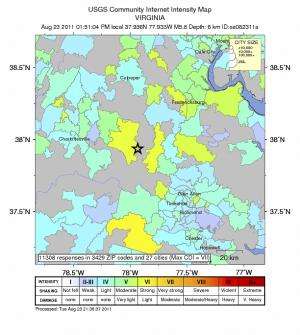Stanford geophysicist offers insight into the Virginia earthquake

(PhysOrg.com) -- The magnitude 5.8 earthquake that struck central Virginia on Tuesday was a rare event for the East Coast, but not a surprising one, according to Mark Zoback, a professor of geophysics at Stanford.
"This is an area where small earthquakes had occurred in the past and were well-documented," he said.
The earthquake was centered approximately four miles beneath the town of Mineral, Va., which lies roughly halfway between Charlottesville and Richmond.
There were reports that the shaking was felt as far north as Philadelphia, New York City and Martha's Vineyard in Massachusetts, where President Obama and his family were vacationing.
Although the magnitude of the earthquake was unusual for the area, sizable earthquakes have occurred in the central and eastern United States in the past.
A large earthquake struck Charleston, S.C., in 1886. In 1811 and 1812, three very large earthquakes hit the area near New Madrid, in southern Missouri. The largest of the New Madrid earthquakes reportedly rang church bells as far away as Boston.
Why there?
The subterranean forces that are responsible for earthquakes are the same ones driving plate tectonics, the slow movement of giant tectonic plates across the surface of the Earth. Those forces, which ultimately originate deep inside the planet, are transmitted through the plates, Zoback said. "Almost everywhere, continental interiors are highly stressed, and just because earthquakes are rare in places like the eastern U.S. doesn’t mean they won't occur someday."
The tectonic plates are part of the rigid outermost layer of the Earth, called the lithosphere, which is about 100 kilometers thick.
The upper part of the lithosphere, from the surface down to about 15 kilometers, is brittle and breaks during earthquakes. But rock in the deeper and hotter part of the lithosphere is ductile and flowing slowly all the time.
"While the plates seem to be rigid, they are in fact slowly deforming, and this earthquake is part of that steady slow deformation process," Zoback said. "The fact is that the entire lithosphere is deforming all the time – the upper part deforms through earthquakes, the lower part deforms through very slow flow."
In general, Zoback said, earthquakes of this size don't cause extensive damage if modern building codes are in force. Reports from the East Coast indicated that overall damage was fairly minor.
Aftershocks will likely be common over the next couple of weeks, but will taper off in both size and frequency.
"Generally speaking, the largest aftershock is about one magnitude unit smaller than the main shock," Zoback said. That suggests that the largest aftershock in the coming days will be about a magnitude 5.
The effects of the East Coast earthquake may be different in at least one way from those that strike California.
"A characteristic of the eastern United States is that the shaking from a given size earthquake is felt over a much larger area than it is in the western part of the country," he said.
"That is because the seismic waves are transmitted more easily through the old and stiff Earth's crust that underlies the East."
Provided by Stanford University
















